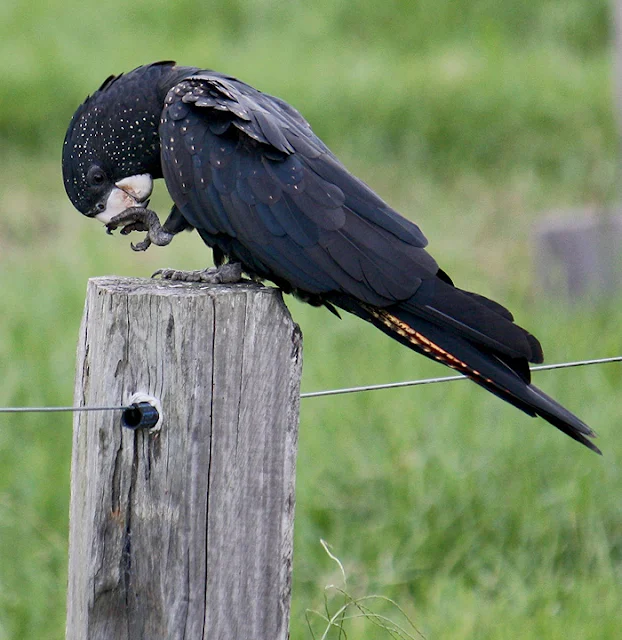A Pandemonium Of Parrots
After a funny sort of day at work, it was agreed that we should pull the pin early (being POETS day and all) and head to mine for some refreshment. So we got here, kicked off our boots and started swapping lies over a couple of beers as blokes do.
Jo got home, room was made and all were catching up when out of nowhere a flock of Red-tailed Black Cockatoos flew over head. We all oooo'd and aaaah'd as we don't normally see them this close to the coast and generally agreed that they're beautiful birds ...
Anyway, so Dan splits and almost immediately the phone goes - it's Dan ...
"Mate, those birds are about 50 metres from your place ..."
" ... cheers mate" - click.
Camera, no time for shoes ... here's some of the pics.
I love parrots, if you've ever spent any time at all with them, you'll know just how engaging they can be. These guys are quite common, although as I said, we don't normally see them here.
Unfortunately, they are sometimes an agricultural 'pest' and as such are probably killed in quite large numbers - which saddens me immensely.
The males have a crest and red 'flags' on the underside of their tales, but IMO the females are just as pretty with their stars at night speckles.
Now I ask you - is the bird pictured above telling a story that the other birds are listening to or what? They are hugely gregarious and watching them play and squabble should, I think, be prescribed for those of us who suffer from black dog days.
An excellent start to the weekend and one of those wildlifey moments where I feel incredibly fortunate to see such amazing animals - and big cheers to my man Dan, for the heads-up.
Hope you enjoyed the post - take care
Jo got home, room was made and all were catching up when out of nowhere a flock of Red-tailed Black Cockatoos flew over head. We all oooo'd and aaaah'd as we don't normally see them this close to the coast and generally agreed that they're beautiful birds ...
Anyway, so Dan splits and almost immediately the phone goes - it's Dan ...
"Mate, those birds are about 50 metres from your place ..."
" ... cheers mate" - click.
Camera, no time for shoes ... here's some of the pics.
 |
Calyptorhynchus banksii |
I love parrots, if you've ever spent any time at all with them, you'll know just how engaging they can be. These guys are quite common, although as I said, we don't normally see them here.
Unfortunately, they are sometimes an agricultural 'pest' and as such are probably killed in quite large numbers - which saddens me immensely.
 |
Don't tell anyone - but ... |
 |
Did you hear? |
 |
On approach |
 |
That was a bit hair-raising ...eh? |
The males have a crest and red 'flags' on the underside of their tales, but IMO the females are just as pretty with their stars at night speckles.
 |
She's seeing Terry? ... TERRY! for crying out loud |
Now I ask you - is the bird pictured above telling a story that the other birds are listening to or what? They are hugely gregarious and watching them play and squabble should, I think, be prescribed for those of us who suffer from black dog days.
 |
Right - everyone freak out to the left okay? |
 |
I don't care - I'm chewing it ... |
The species complex was first described by the ornithologist John Latham in 1790 as Psittacus banksii, commemorating English botanist Sir Joseph Banks.
The Red-tailed Black Cockatoo also has the distinction of being the first bird from Eastern Australia to be illustrated by a European -
A female, thought to have been collected at Endeavour River in north Queensland, was sketched by Banks' draughtsman Sydney Parkinson in 1770. ^
 |
They're idiots. Yes dear, they are. |
 |
Did someone just call me an idiot?. |
An excellent start to the weekend and one of those wildlifey moments where I feel incredibly fortunate to see such amazing animals - and big cheers to my man Dan, for the heads-up.
Hope you enjoyed the post - take care
The Red-tailed Black Cockatoo (Calyptorhynchus banksii) also known as Banksian or Banks' Black Cockatoo, is a large black cockatoo native to Australia. Adult males have a characteristic pair of bright red panels on the tail that gives the species its name.
It is more common in the drier parts of the continent. Five subspecies are recognised, differing most significantly in beak size. Although the more northerly subspecies are widespread, the two southern subspecies, the Forest Red-tailed Black Cockatoo and the South-eastern Red-tailed Black Cockatoo are under threat.
It is more common in the drier parts of the continent. Five subspecies are recognised, differing most significantly in beak size. Although the more northerly subspecies are widespread, the two southern subspecies, the Forest Red-tailed Black Cockatoo and the South-eastern Red-tailed Black Cockatoo are under threat.






Comments
DR
Post a Comment